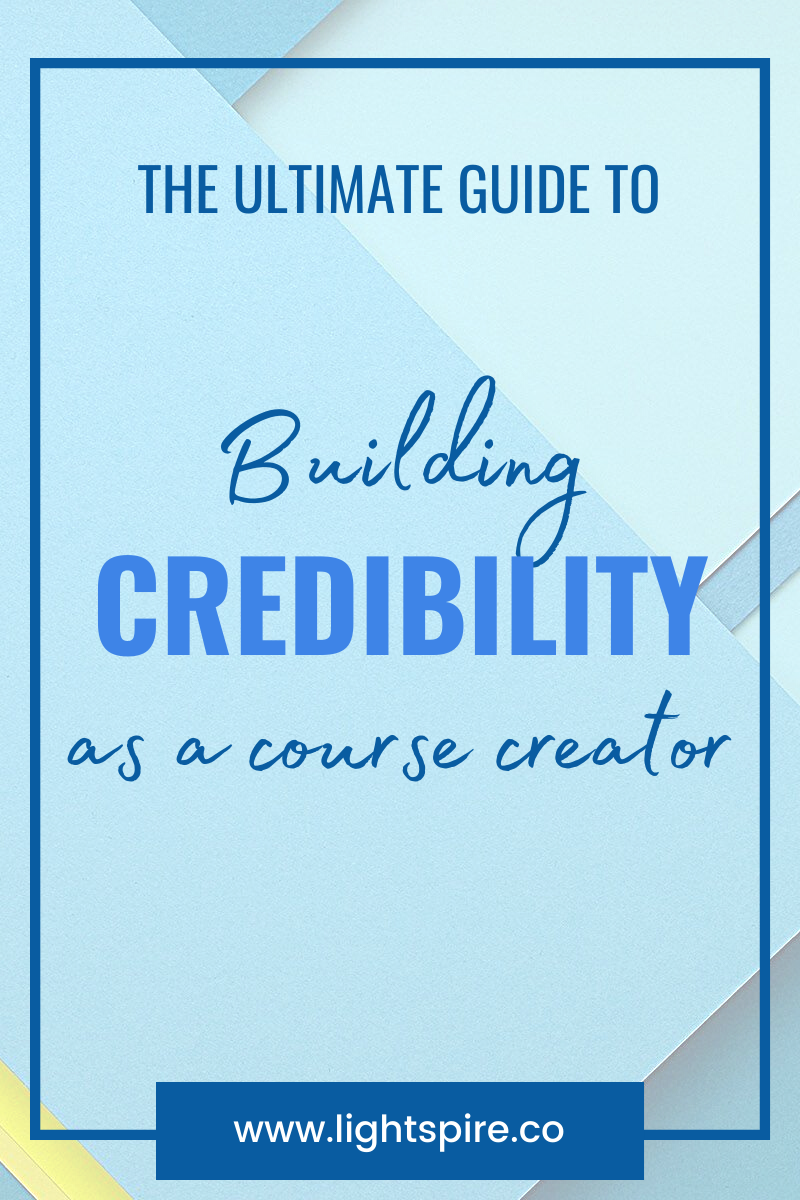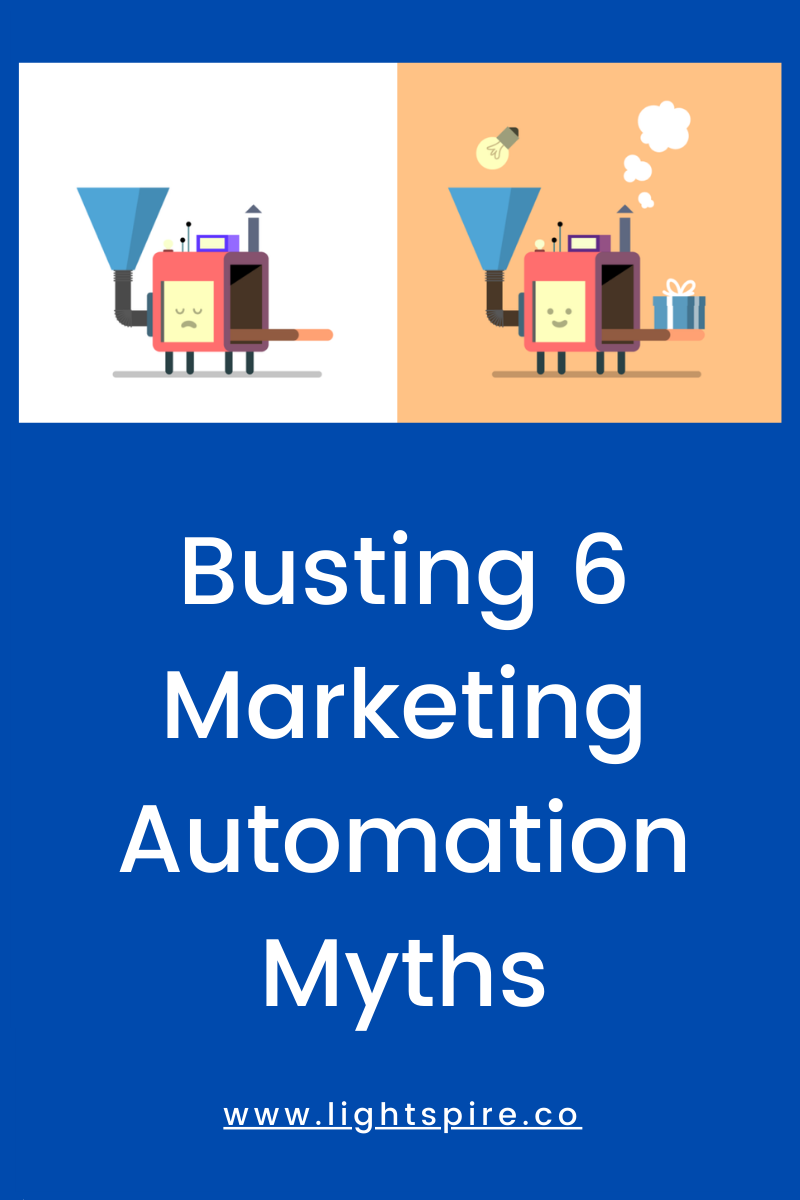The Ultimate Guide to Building Credibility as a Content Creator
If you’re selling a course that you’ve created online, you’ve likely noticed that online learners have some trust issues. And to be fair, they have good reasons to wonder which creators to trust. There has been an explosion of online learning and educational content in the past couple of years, and not all courses are created equal.
So how do you show your learners your expertise and build credibility as a course creator? Telling your learners that you have great content won’t cut it - so how can you build enough trust that they will sign up for your course and see the value for themselves?
The basics of credibility
This guide may seem long. And it is, because it offers a pretty exhaustive overview of the many things that you can do to improve your credibility within your course, on your website, on social media, and elsewhere.
But there is a simple idea behind every action on this list. If you want the quick takeaway to turn into immediate action, it’s this:
You gain credibility by doing everything you can to show that you’re trustworthy, while letting others say that you’re trustworthy.
This means that as creators, we need to show that we are capable and effective experts, with the knowledge and the drive to help our learners solve their most pressing problems. But when it comes to saying that, we need to step back and let others do the talking.
The message will be much more powerful coming from people that the learner already trusts (such as their friends, other experts in the industry, and other learners) than from us.
That doesn’t mean we do nothing - there are many effective ways of displaying trustworthiness that don’t rely on screaming, “I’m trustworthy!” into the ether.
Below, we’ll discuss 17 proven ways to build your credibility with learners and gain their trust.
In This Guide:
- 1. Tell your story
- 2. Fill your trust battery
- 3. Display social proof
- 4. Show up on other sources
- 5. Add pictures of yourself
- 6. Show the transformation
- 7. Pair up with other experts
- 8. Give away freebies
- 9. Speak their language
- 10. Build in public
- 11. Use statistics and research
- 12. Beef up your site security
- 13. Get recommended by experts
- 14. Create a great user experience
- 15. Boost page performance
- 16. Perfect your grammar and punctuation
- 17. Provide contact information
1. Tell your story
No one wants to buy from a robot, or a faceless content machine. To that end, your first task is to show your audience who you are. Potential learners want to know about your background, why you’re the perfect person to teach your subject, and what it will be like to spend hours with you during the course.
Include a short bio on the landing page for your course, as well as on a separate “about me” page. But don’t stop there. Interact regularly with your audience on your favorite social media channels and introduce yourself in other online communities. Your goal is to show your audience who you are, and make them understand the person behind the course so that they trust you as an instructor.
2. Fill your trust battery
Building trust is the foundation for credibility and a strong relationship with your audience. And while it may seem like trust and credibility are the same thing, there’s actually an important distinction. Credibility means that your audience believes your course will provide the value and the transformation that you say it will. It’s a pretty narrow definition.
Trust, on the other hand, describes your entire relationship with your audience. Beyond the course, do they believe that you have their best interests in mind? Are you there to provide value every step of the way, or do you always have the next sale in mind?
Customers can see thinly veiled sales attempts from a mile away. If you only ever send emails when you’re launching something, or only ask questions on social media when there’s something in it for you, customers won’t want to spend time with you (online or off).
If, on the other hand, you provide value every time you speak, you’re filling up your audience’s “trust battery.” Each time you ask for something in return, or don’t deliver on a promise, you’re draining that battery. Endeavor to keep it at at least 75% full and you’ll be well on your way to building a real relationship with your learners.
Here are a few great ways to build up your “trust battery”:
Answer questions on Twitter or Reddit
Tell your audience when to expect your emails, then follow through
Publish content regularly
Give generous freebies and incentives on your site
Highlight the work of others in your space
Help your audience find other resources besides yours
Respond to all feedback, positive and negative
3. Display social proof
Once the positive reviews for your course start pouring in, it’s time to highlight them. Humans are social creatures, and depend on the opinions of others as an important marker of quality.
Think about it this way: if you had to research every detail about a product every time you wanted to buy something new, you wouldn’t have time for anything else. But if you can look at reviews online, or better yet speak to a friend about a brand that they trust, you can skip over a lot of needless research and instead just find out the details relevant to your situation.
Social proof can come in the form of video testimonials, quotes, and star ratings, but there are other great ways to show that others trust you as well. You can add the logos for businesses who have gotten involved. You can display a count of students who have signed up in the last week. You can even use services like Proof to display a popup every time you get a new course purchase.
Example
The success of Corey Haines’ Swipe Files community depends on a reputation of high-quality resources for marketers. Corey establishes credibility for himself and his community prominently above the fold on the home page in the form of some beautifully designed testimonial graphics with quotes from marketing experts.
Consider creative ways to show off your social proof that make sense for your brand and your course material. For instance, the best social proof for a photography course is probably the beautiful photos that students take after learning through the course. What are some ways to show that others trust you and have found value in your course?
4. Show up on other sources
Your ideal learners have a number of “digital watering holes” that they show up at on a daily or weekly basis. These are the places where your learners feel comfortable asking questions, connecting with like-minded individuals, and “nerding out” about their favorite topics. If you’re not there with them, you’re missing out on a huge opportunity.
Participating actively in discussions in places that your learners already trust will reflect well on you, and transfer some of that trust to you over time. You don’t have to be the main expert on the site, the most popular influencer, or even the most active user. All you need is regular engagement where you provide value, listen to others, and add to the discussion.
It can be a bit tough to find the watering holes where your audience is hanging out, but it’s worth the effort. Becoming an active member of the right sites will give you ideas for future content, a place to ask questions of your audience, and a place to announce new and exciting things that you have to share.
To find the watering holes for your audience:
Google the terms your audience would use to describe themselves, including lots of variations
Google questions that your audience would have about your topic, with lots of variations
Use industry specific jargon to find discussions and searches related to your industry
Search for specific tools your audience uses to do their jobs better (hardware, software, etc)
Ask current customers where they go online when they need help!
Once you find those watering holes, start providing as much value as you can and creating relationships with your audience. That’s not just a credibility tool - by truly understanding your audience you’ll know what they want and need, and can create better courses in the future.
5. Add pictures of yourself
Customers don’t buy from companies - they buy from people. Become more real and memorable for your learners and introduce yourself as a person by including a few pictures of yourself. These should be a chance to show off your personality and give learners a taste of what your course might be like.
Your pictures should be consistent with the feeling of your course in order to be credibility boosters. For instance, if you’re a fitness instructor you’ll want to make sure you have some photos of yourself exercising, or at least in workout gear. If you show up in a ballgown your learners will be incredibly confused (or impressed that you can work out in a ballgown.) For B2B courses you’ll want to keep your photos a bit more buttoned up, depending on the industry. For creative courses you can be more casual and show off more personality in your pictures.
Make sure your images are polished and professional looking, and don’t have any other people in them (unless they’re part of the message.) And whatever you do, don’t forget to smile!
6. Show the transformation
To establish credibility with your learners, you need to show them that you can solve their main problem.
To do this, you need to highlight the transformation that your learners go through.
What is the beginning state of someone with this problem? What does the pain look like for them? How would they describe the problem in their own words? This information should be somewhere near the beginning of your landing page to establish that you understand the audience and the problem (and to weed out the learners who won’t get value from your course.)
Then comes the transformation: What does it look like when someone solves the problem? How do they feel? What can they do now that they couldn’t before? What are the other effects on their lives?
If you can show the transformation in photos, video, or testimonials, you’ll boost credibility with your audience and show them that they can get the transformation that they’re looking for. As you share content on social media, keep that transformation in mind - any time that you can highlight how a learner benefited from your course will be more impactful than you simply sharing information about the course itself.
Example
Sunny Lenarduzzi is a YouTube expert who teaches creators how to grow their audience on the channel. Her transformation promise is that learners will, “be seen by a bigger audience and create an impact using their unique genius.” By creating a “wall of fame” for learners who have reached 100,000 YouTube subscribers, Sunny shows the transformation that her course provides and displays her credibility as an instructor.
7. Pair up with other experts
If you don’t have an established brand yet, it’s time to pair up with others who do. No matter what industry you’re in, there are trusted experts that your audience is already looking to for advice. Who are those people? Where do they interact with your audience? What ideas do they discuss?
Make a list of 5-10 “high priority” experts that you’d like to work with. Start out with experts who have some reach, but are not the superstars in your field. You ideally want to find people who still respond to messages, are doing a lot of their own marketing, and can see the benefits of working with you even though you don’t yet have a large audience.
Once you’ve found those experts, start interacting with them. Ask questions, provide helpful resources for them, and share their content. When you have a good idea of their brand and worldview, send them a note that outlines how you could work together, and how their audience will benefit.
8. Give away freebies
Giving things away builds goodwill with your audience, and helps them to associate your brand with something of value. If you’re consistently providing good information and being generous with time and resources, you’ll boost credibility with your audience.
Make sure your freebies are related to the course that you’re promoting and provide value for the same audience as the course. For instance, if your “postpartum fitness” course is geared towards new moms, you could create a “30 day postpartum workout plan”, “postpartum nutrition guide”, or “postpartum core exercises cheat sheet” as valuable freebies for the same audience.
Your freebie should focus on one specific topic, and should leave your learners with a few questions that your course can answer. You can even include a discount code for the course in the freebie, so that learners have an incentive to continue learning with you.
Example
Jay Acunzo is a creator that I really admire, especially when it comes to creating value for podcasters. He has a course that teaches podcasters to “develop [their] ideas into an irresistible premise [their] audience loves and shares”. He immediately connects with his audience, establishes credibility, and displays the value he can offer by giving away a free lesson at the top of his course page.
9. Speak their language
Every industry has its jargon. This is language that people speak when they’re discussing the industry, whether they realize it or not. By speaking to your audience in the same language you show that you understand the space and have experience in it.
This helps to boost your credibility, as long as it’s done in a genuine way. If you don’t understand the jargon, or are inserting jargon for its own sake, your learners could be turned off. It’s important to find a balance, and speak to your audience about the problem the way they speak about it to each other.
10. Build in public
There has been a trend in recent years towards transparency in all its forms. This started with founders sharing their journeys building startups, and continued with businesses of all kinds sharing successes and failures as they grew, to sharing hard numbers related to their revenue, profits, and growth metrics. The trend now pervades many industries, with everyone from large companies to individuals sharing their progress as they grow.
Example
Blake Emal, CMO at copy.ai, is a great example of a creator building in public. From publishing his wins and losses to Twitter, to announcing projects before he starts them, to letting others know when he runs into obstacles, he tells and shows it all. Because of that, he has a loyal following of marketers and others who want to learn from him and trust him.
Building in public is a huge credibility booster because your audience gets a full picture of you and your business. They know that you’ll share both successes and failures, and that you’ll tell them when you run into challenges. You also build trust because your audience can see the things that you’re committing to doing, and knows when you follow through on them.
11. Use statistics and research
For a certain type of learner, statistics and data are the only real things to trust. By using research from reputable sources in your writing, you add perspective to the topic and show that your assertions are based on facts. You can find relevant research for your industry by subscribing to industry reports, searching reputable data sources online, or reading about your topic in well-known publications.
If you want to take it one step further, consider conducting your own research. By putting out your own survey or conducting interviews with your audience, you’ll access an exclusive source of data that other content creators don’t have.
12. Beef up your site security
It’s 2021, and not having basic website security in place will quickly get you laughed out of the (metaphorical) room. Take a look at the URL for your page in your web browser. If your URL doesn’t start with “https”, you’re missing a basic opportunity to establish credibility. Https simply means that your site has a valid SSL certificate. It’s not a guarantee of site safety, but it offers a foundational level of assurance for the average user.
Many browsers also display a padlock symbol in the URL bar to display a measure of security. The padlock means that data between the visitor and the site is encrypted. This is important for any site where a user is inputing potentially sensitive information. For example, users will often look for the padlock symbol when interacting with sites that require their financial information, like credit card details.
If your industry requires certain security standards, make sure to tell your users about them on your site. Badges, certificates, and security ratings from third parties all help to show that you take site security and data protection seriously.
13. Get recommended by experts
It’s great if you can collaborate on content with other experts in your industry, but it won’t always be possible. In these cases it can still be helpful to ask those experts for quick feedback on your course.
If the expert likes what they see, they may end up giving you a good review, sharing your course on social media, or even endorsing it for their own audience.
Pick a few experts that you would like to get feedback from and send them your course for free. Explain why you’re reaching out to them, how your audiences overlap, and how they can be helpful. Be super specific in your ask, and do everything you can to make it easy for them to respond. You may end up with a great review from a star in your field!
14. Create a great user experience
When thinking about your credibility as a course creator, the user experience of your site may not be the first thing that comes to mind. But poor site navigation, broken links, and confusing forms will send potential learners running the other way pretty quickly.
There is simply too much great content online for users to spend any extra time on a poor website experience. For many learners, seeing a broken link gives the impression that you don’t have enough attention to detail. They worry that that will carry over to the course, and that your content will have similar mistakes.
Once you’ve created your site and landing page, run it by a few people to get their feedback. Choose people in your audience who have some familiarity with your topic, but also include some who know nothing about it. If your site is easy to navigate for your favorite technology-impaired relative, you can be reasonably sure that your audience will have no problems with it.
To get the most out of your user experience interviews, ask specific questions about the experience. Have the user share their screen as they click through the site, preferably while narrating what they’re doing and why. They should explain what they expect to happen when they click on a button or submit a form, what things aren’t making sense, and how each page makes them feel. Record the sessions or take good notes, and start making changes once you see a pattern from a few users.
15. Boost page performance
While I would love to say that your site visitors are patient and understanding people, it’s unlikely to be true. At least in regards to site speed and performance, most people have a remarkably low tolerance for obstacles.
This means that if your site takes more than 3 seconds to load (yes, only 3), has less intuitive navigation, or doesn’t work exactly the way a user expects, they will likely leave and never return.
That sounds harsh, but it’s an important truth that you need to be aware of if you want your users to stick around long enough to buy a course.
In terms of credibility, page performance doesn’t do a lot to add trust - but it can definitely decrease it. Possibly without even knowing it, visitors who see broken links, images that won’t load, or slow speeds will have less trust in your ability to deliver a course without technical glitches, or they may feel that you are less professional and experienced than they originally thought.
Here are the top ways to boost your credibility with page performance:
Use a tool like Google’s Page Speed Insights to get an idea of how your site is currently performing. The tool will also give you suggestions for improving speed
Compress your images to make them load quickly. You can use a free tool like Optimizilla’s Image Compressor to reduce the file sizes of your pictures while maintaining their high quality.
Test all of your links to make sure they go where you want them to, and test them again each time you update your site
If you’re running ads, make sure that the pages they point to match the messaging of the ad. Visitors will quickly leave if they click on an ad for your fitness course and land on a page about your nutrition course.
16. Perfect your grammar and punctuation
Just like poor page performance, poor grammar and punctuation can lead your visitors to make unfair assumptions about your professionalism, expertise, and credibility. It’s worth double-checking your grammar and spelling before publishing any of the content related to your course to make sure it’s free of errors.
You can use a tool like Grammarly to check your spelling, punctuation, and 250+ types of common and advanced English grammar rules, as well as the tone of your website copy and how others might perceive it.
It of course might be part of your brand to speak to your learners in a casual tone, but don’t take it too far. It’s rare that spelling mistakes or overly casual grammar will add to your credibility.
17. Provide contact information
Lastly, you’ll want to make sure that potential learners have a clear and easy way to contact you with questions. At the very least, include an email address, phone number, or contact form on your website so that visitors can easily get in touch.
Other communication tools can also add to your credibility. Tools like SimpleTexting make it really easy to send SMS campaigns and receive questions one-on-one from potential learners, and show that you’ve put in the extra effort to connect with your audience and make learning easy.
Hopefully all of these tips have given you some good ideas for how to demonstrate credibility to current and potential students. Remember that at its core, credibility is all about showing that you are trustworthy while letting others do the talking about your trustworthiness.
Do you have any other ways that you’ve boosted your credibility as a course creator? Questions about how to apply these tips to your situation? Let me know on Twitter or in the comments!













